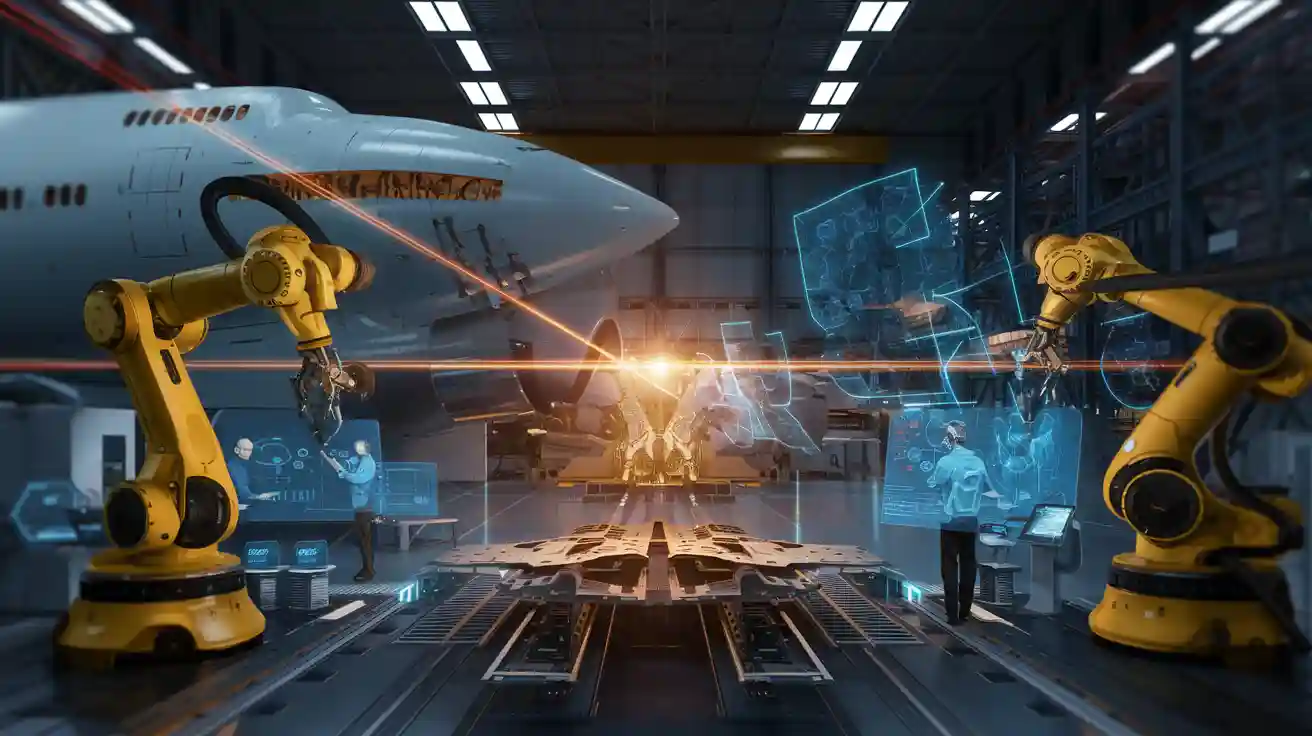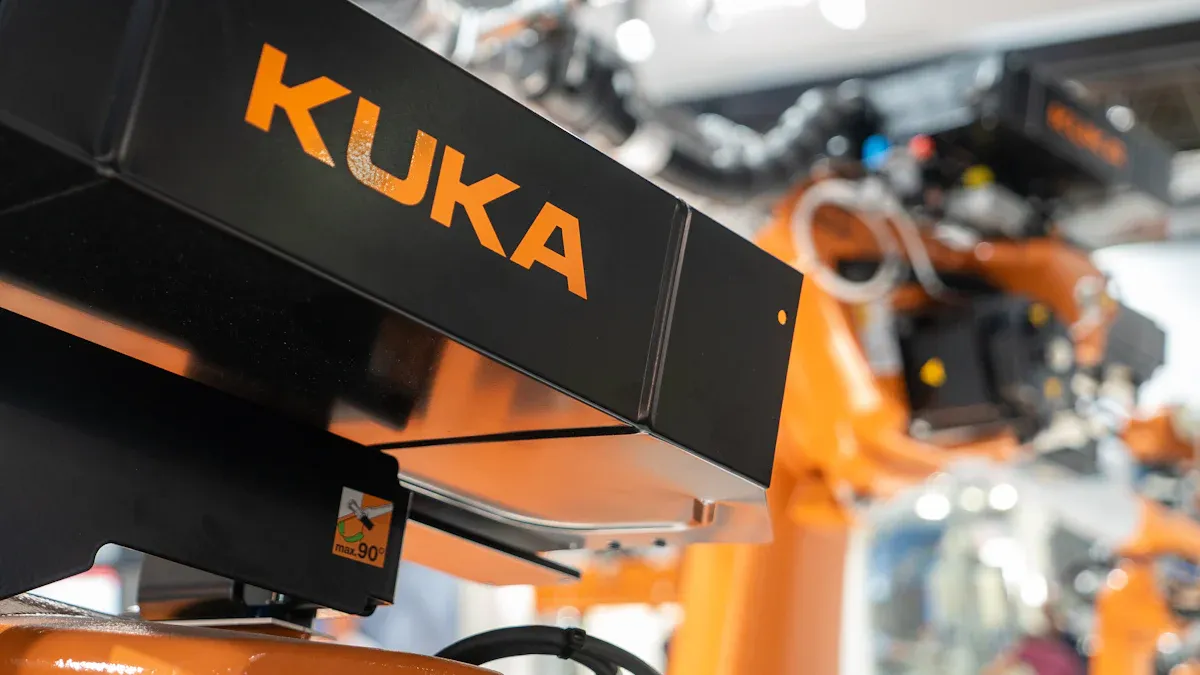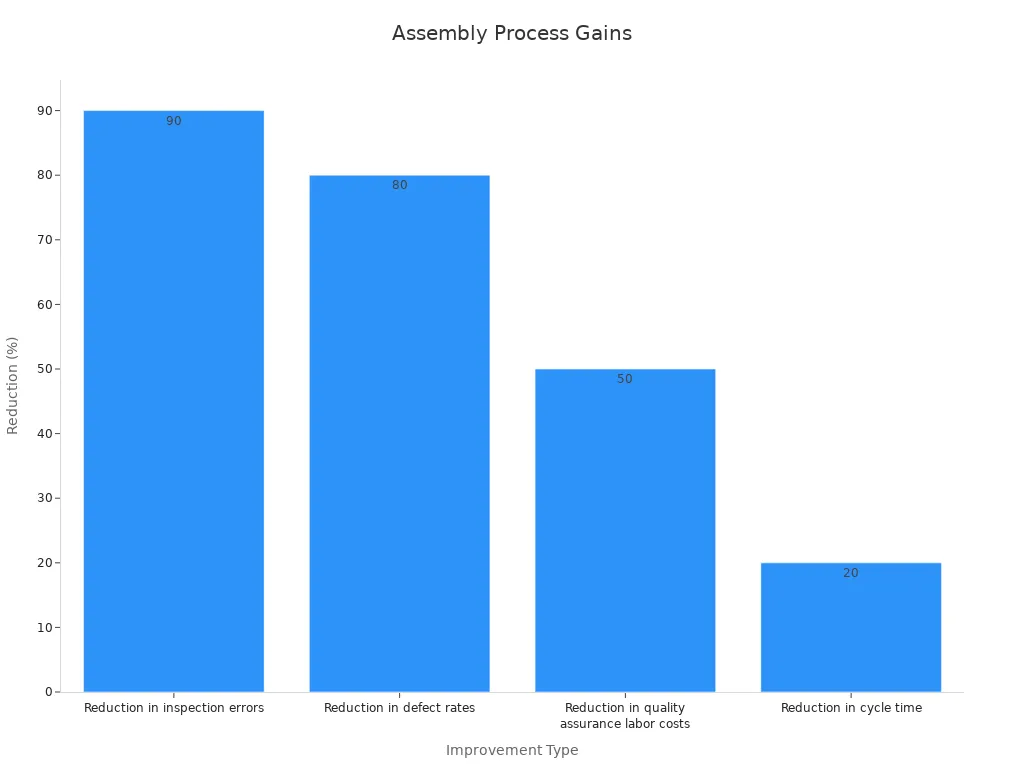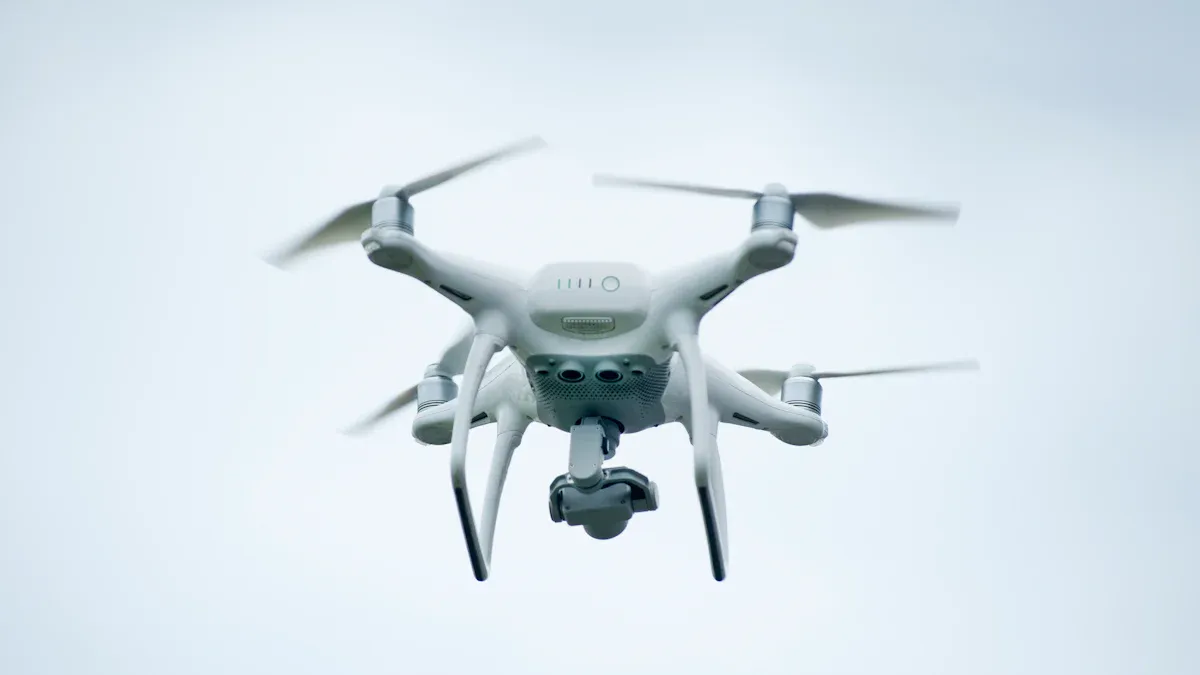How Machine Vision Systems Revolutionize Aerospace Manufacturing Processes

Aerospace manufacturing demands precision and efficiency at every stage. Machine vision systems enable you to meet these demands by automating critical processes and enhancing accuracy. These systems identify defects with remarkable precision, ensuring high-quality components. For example, a leading manufacturer achieved a tolerance of ±0.005 mm on engine parts, reducing the risk of malfunctions. Advanced imaging and AI technologies also play a vital role in defect detection, minimizing manual errors and improving quality control. With their ability to streamline production and maintain stringent standards, aerospace machine vision systems are transforming the industry.
Key Takeaways
- Machine vision systems check parts automatically, making them accurate and reducing mistakes.
- These systems make aircraft safer by finding problems early and stopping failures.
- Adding machine vision to current methods saves time, cuts waste, and lowers costs.
- AI and machine learning help find defects and predict repairs, improving quality checks.
- Using smart software helps make better choices and follow strict aerospace rules.
Understanding Aerospace Machine Vision Systems
Definition and Core Components
Machine vision systems are advanced technologies that enable machines to "see" and interpret visual data. These systems play a critical role in aerospace manufacturing by automating inspections, detecting defects, and ensuring precision. To function effectively, they rely on several core components:
- Lighting: Provides consistent illumination for capturing clear images of components.
- Image Processing Software: Analyzes images to identify patterns, detect flaws, and measure dimensions.
- Hardware Interfaces: Connects cameras, sensors, and other components, ensuring seamless communication.
- Processing Units: Handles complex computations for real-time image analysis.
- Calibration Tools: Ensures accurate alignment and measurements during inspections.
- Integration and System Design: Combines all components into a cohesive system for optimal performance.
Each of these components works together to deliver the precision and reliability required in aerospace manufacturing.
Importance in Aerospace Manufacturing
You rely on machine vision systems to meet the high standards of aerospace manufacturing. These systems ensure that every component meets strict quality requirements. For example, they automate the inspection of heads-up displays (HUDs) for jet fighters. By using pan-tilt-zoom cameras and structured lighting, they perform detailed visual checks. This reduces human error and guarantees consistent quality.
Automated inspections also free up operators to focus on other tasks, improving overall efficiency. In addition, machine vision systems enhance safety by identifying defects that could lead to failures. Their ability to process large volumes of data quickly makes them indispensable in modern aerospace production lines.
By integrating these systems, you can achieve higher precision, reduce waste, and maintain the reliability that the aerospace industry demands.
Applications of Machine Vision Systems in Aerospace Manufacturing

Quality Control and Defect Detection
You rely on machine vision systems to meet the rigorous quality control standards of aerospace manufacturing. These systems excel in defect detection, identifying even the smallest flaws that could compromise the quality of parts. For instance, vision inspection technologies use high-resolution cameras and advanced imaging software to perform precision-based inspections. This ensures that every component meets strict specifications before moving to the next stage of production.
Machine vision systems also enhance process monitoring by providing real-time feedback. This allows you to address issues immediately, reducing the risk of defects in final inspection stages. By automating complex inspections, these systems minimize human error and improve overall quality assurance. As a result, you can maintain the reliability and safety that the aerospace industry demands.
Component Traceability and Serialization
In aerospace manufacturing, traceability is critical for ensuring the safety and reliability of components. Machine vision systems play a vital role in this process by enabling accurate tracking, sorting, and identification of parts. These systems use traceability software to provide full lifecycle tracking for critical components like turbines and airframes. This ensures that every part meets strict safety guidelines and protects the supply chain from counterfeit parts.
The following table highlights the role of machine vision in component traceability and serialization:
| Evidence Description | Role of Machine Vision |
|---|---|
| Vision system enables tracking, sorting, and identifying. | Critical for complete traceability. |
| Ensures that the right data is going to be marked on the right part. | Confirms accuracy in the marking process. |
| Traceability software provides full lifecycle tracking for critical components like turbines and airframes. | Ensures every part meets strict safety guidelines and improves overall reliability. |
| Protects the supply chain from counterfeit parts. | Critical for maintaining compliance and safety standards. |
| Integrate vision technology to verify accuracy and grade marks. | Enables tracking, sorting, and identifying through part type, orientation, and mark area recognition. |
| Confirms there were no errors in the marking process. | Ensures that the right data is marked on the right part, critical for complete traceability. |
By integrating machine vision systems, you can achieve unparalleled accuracy in serialization and traceability. This not only enhances the quality of parts but also ensures compliance with industry regulations.
Automation in Assembly and Inspection Processes
Automation through machine vision systems has revolutionized assembly and inspection processes in aerospace manufacturing. These systems streamline operations by automating repetitive tasks, reducing cycle times, and improving efficiency. For example, vision inspection technologies can identify defects during assembly, ensuring that only flawless components proceed to the next stage.
Statistical data underscores the impact of automation on assembly and inspection processes:
| Improvement Type | Statistic |
|---|---|
| Reduction in inspection errors | Over 90% reduction compared to manual inspection |
| Reduction in defect rates | Up to 80% reduction in defects |
| Reduction in quality assurance labor costs | Approximately 50% reduction in labor costs |
| Reduction in cycle time | Up to 20% reduction in cycle time |

By automating assembly and inspection, you can achieve significant cost savings and improve production efficiency. These systems also enhance quality inspection by providing consistent and accurate results. This ensures that every component meets the highest quality control standards, reducing the risk of failures and enhancing overall reliability.
Enhancing Safety with Vision Systems
Safety is a top priority in aerospace manufacturing. Machine vision systems play a critical role in enhancing safety by identifying potential risks and ensuring components meet stringent standards. These systems use advanced imaging technologies to detect defects that could compromise the integrity of parts. For example, they can identify micro-cracks in turbine blades or irregularities in fuselage panels during production. Early defect detection prevents failures during operation, safeguarding both equipment and lives.
You can rely on machine vision systems for real-time process monitoring. These systems continuously analyze production data to identify anomalies. If a deviation occurs, the system alerts operators immediately, allowing you to take corrective action before the issue escalates. This proactive approach minimizes risks and ensures consistent quality throughout the manufacturing process.
Safety also improves during final inspection stages. Machine vision systems perform thorough quality inspection of components, ensuring they meet all safety requirements. For instance, they verify the alignment of critical parts like landing gear assemblies or engine mounts. By automating these inspections, you reduce human error and achieve higher accuracy.
Here are some ways machine vision systems enhance safety in aerospace manufacturing:
- Defect Detection: Identifies flaws like cracks, misalignments, or surface irregularities that could lead to failures.
- Process Monitoring: Provides real-time feedback to detect anomalies and prevent unsafe conditions.
- Quality Inspection: Ensures components meet strict safety standards during final inspection.
- Predictive Maintenance: Monitors wear and tear on equipment, helping you address issues before they become critical.
Tip: Integrating machine vision systems into your production line not only enhances safety but also boosts efficiency. By automating inspections and monitoring processes, you can focus on innovation and growth.
Aerospace machine vision systems are indispensable for maintaining safety in manufacturing environments. Their ability to detect defects, monitor processes, and ensure quality makes them a cornerstone of modern aerospace production.
Technologies Driving Aerospace Machine Vision Systems
High-Resolution Cameras and Imaging Sensors
High-resolution cameras and imaging sensors form the backbone of modern aerospace machine vision systems. These technologies allow you to capture detailed images of components, enabling precise inspections and measurements. High-speed thermal cameras, for instance, have significantly improved in pixel resolution and frame rates. This advancement provides more measurement pixels during tests, which is crucial for applications like aerodynamics studies and component stress testing. You can also use these cameras to visualize airflow patterns, gaining better insights into thermal gradients and improving non-contact temperature measurements.
Recent innovations in high-speed vision technology have further enhanced performance. Some cameras now capture over 1 million frames per second at lower resolutions or maintain 4K resolution at 1,000 fps. These capabilities allow you to observe ultra-fast phenomena with unprecedented detail. Additionally, new sensor technologies offer improved sensitivity and dynamic range, making them ideal for low-light aerospace environments. Whether you are conducting flow visualization or inspecting critical parts, these advancements ensure higher accuracy and reliability in your processes.
Artificial Intelligence and Machine Learning
Artificial intelligence (AI) and machine learning (ML) are revolutionizing aerospace manufacturing by optimizing machine vision systems. These technologies enable you to analyze vast amounts of production data in real time, identifying patterns that help predict potential quality issues. Predictive quality analytics, powered by AI, allows you to address problems before they arise, reducing downtime and improving overall efficiency.
AI-powered vision inspection systems also enhance automated quality inspections. By using high-resolution cameras, these systems capture detailed images of components and compare them against predefined quality standards. This process ensures that every part meets strict specifications, minimizing errors and improving inspection speed. Machine vision AI excels in object recognition, enabling you to identify and classify components with remarkable accuracy. These capabilities make AI and ML indispensable for maintaining the high standards required in aerospace manufacturing.
3D Vision and Imaging Technologies
3D vision and imaging technologies are transforming how you inspect and evaluate aerospace components. These systems provide a comprehensive view of parts, enabling you to detect flaws that might go unnoticed with traditional 2D imaging. For example, CT scanning has proven invaluable in inspecting 3D-printed rocket components. By identifying defects early, you can make adjustments to improve part quality and reduce waste.
In aerospace manufacturing, 3D in-line inspection plays a critical role in ensuring the integrity of mission-critical components. This technology allows you to perform thorough quality checks on parts like turbine blades and fuselage panels. By assessing these components in detail, you can ensure they meet safety and performance standards, reducing the risk of in-flight failures. Additionally, 3D imaging enhances object recognition, helping you verify the alignment and dimensions of complex assemblies. These capabilities make 3D vision systems an essential tool for achieving precision and reliability in aerospace production.
Tip: Incorporating 3D vision technologies into your workflow not only improves quality assurance but also supports innovation in aerospace design and manufacturing.
Advanced Data Processing Software
Advanced data processing software plays a pivotal role in aerospace manufacturing. It enables you to analyze vast amounts of data quickly and accurately, ensuring that production processes remain efficient and error-free. These tools process complex datasets from machine vision systems, transforming raw information into actionable insights. By leveraging this software, you can enhance decision-making and maintain the high standards required in aerospace production.
One of the key advantages of advanced data processing software is its ability to adapt to changing conditions. For example, dynamic sampling adjusts sample sizes based on data variability. This ensures that inspections remain accurate even when production conditions fluctuate. Real-time analytics further enhances this capability by continuously integrating data from various sources. This allows you to monitor system performance during different operational modes, ensuring consistent quality.
Here are some notable features of advanced data processing software in aerospace contexts:
- Dynamic Sampling: Adjusts inspection parameters based on data variability, improving efficiency.
- Real-Time Analytics: Captures and integrates data continuously, enabling you to monitor performance in real time.
- Enhanced Accuracy: Combines statistical methods with machine learning to reduce random errors.
Note: By using these features, you can identify potential issues early and take corrective action before they escalate.
Advanced data processing software also excels in handling large-scale datasets. For instance, it can analyze data from high-resolution cameras and 3D imaging systems simultaneously. This capability allows you to detect subtle defects, such as micro-cracks or surface irregularities, that might otherwise go unnoticed. The software’s ability to process data at high speeds ensures that inspections do not slow down production lines.
The following table highlights how advanced data processing software improves aerospace manufacturing:
| Feature | Benefit |
|---|---|
| Dynamic Sampling | Maintains inspection accuracy |
| Real-Time Analytics | Provides continuous performance data |
| Machine Learning Integration | Reduces errors and enhances precision |
Tip: Incorporating advanced data processing software into your workflow not only improves quality but also boosts efficiency. It helps you stay ahead in a competitive industry by ensuring that every component meets stringent standards.
By adopting advanced data processing software, you can transform your manufacturing processes. These tools empower you to make data-driven decisions, reduce waste, and enhance overall productivity. In aerospace manufacturing, where precision and reliability are paramount, this software is an indispensable asset.
Overcoming Challenges in Implementing Machine Vision Systems
Integration with Legacy Systems
Integrating modern machine vision systems with legacy equipment presents unique challenges. Compatibility issues often arise when older systems cannot communicate effectively with new technologies. This lack of integration can limit visibility across operations and hinder automation. For example, outdated systems may struggle to adapt to Industry 4.0 technologies like AI and IoT.
You may also face high costs when updating or maintaining legacy systems to meet modern standards. These expenses include compliance with regulations and ensuring security against new threats. Outdated systems often lack built-in protections, making them vulnerable to cyberattacks.
Here are some common challenges you might encounter:
- Compatibility issues between old and new systems.
- Limited automation due to disconnected operations.
- High costs of upgrading legacy equipment.
- Resistance from employees to adopt new technologies.
To overcome these challenges, consider phased integration strategies. Start by upgrading critical systems and gradually expand to other areas. This approach minimizes disruptions and ensures a smoother transition.
Addressing Cost and Scalability Issues
The high initial investment required for machine vision systems can deter adoption. System integration often involves complex processes, adding to the overall cost. Additionally, you may need specialized expertise to manage these systems, which can further increase expenses.
Cloud-based solutions offer a scalable and cost-effective alternative. These systems enhance data analysis capabilities and allow for remote monitoring. By leveraging cloud technology, you can reduce upfront costs while gaining flexibility.
Here are some benefits of cloud-based solutions:
- Scalability to meet changing production needs.
- Cost-effectiveness compared to traditional systems.
- Enhanced data analysis and remote monitoring capabilities.
Adopting cloud-based systems can help you address cost and scalability challenges while improving operational efficiency.
Workforce Training and Skill Development
The rapid advancement of AI and machine vision systems is transforming the aerospace industry. To keep up, you need a workforce skilled in AI literacy and data analytics. Studies show that 92% of ICT jobs will experience significant changes due to AI advancements. Mid-level and entry-level positions are particularly affected, with 40% and 37% undergoing major transformations, respectively.
Comprehensive training programs are essential for preparing your team. Focus on developing skills in AI, data analytics, and system integration. Hands-on workshops and online courses can provide practical experience, ensuring your workforce adapts to evolving technologies.
By investing in training, you can build a skilled team capable of leveraging machine vision systems effectively. This not only enhances productivity but also ensures long-term success in a competitive industry.
Ensuring System Reliability in Aerospace Environments
Reliability is critical in aerospace manufacturing. Machine vision systems help you achieve this by ensuring consistent performance in challenging environments. These systems operate under extreme conditions, such as high temperatures, vibrations, and electromagnetic interference. Their robust design and advanced technologies make them indispensable for maintaining precision and durability.
Key Features That Enhance Reliability
Machine vision systems incorporate features that improve reliability in aerospace environments:
- Environmental Resistance: High-performance cameras and sensors withstand extreme temperatures and vibrations.
- Error Detection: Real-time monitoring identifies anomalies, allowing you to address issues before they escalate.
- Durable Components: Systems use rugged materials to ensure long-term functionality in harsh conditions.
Tip: Choose systems with certifications like MIL-STD-810 to ensure they meet aerospace reliability standards.
Real-World Applications
Machine vision systems excel in tasks requiring high reliability:
| Application | Benefit |
|---|---|
| Turbine Blade Inspection | Detects micro-cracks to prevent failures. |
| Fuselage Panel Monitoring | Ensures structural integrity during production. |
| Landing Gear Alignment | Verifies precision to enhance safety. |
These applications demonstrate how machine vision systems maintain reliability across critical aerospace components.
Proactive Maintenance
You can use machine vision systems for predictive maintenance. These systems monitor wear and tear on equipment, helping you identify potential failures early. For example, sensors track vibration levels in engines, alerting you to deviations that could signal damage.
Note: Implementing predictive maintenance reduces downtime and extends the lifespan of your equipment.
By leveraging machine vision systems, you ensure reliability in aerospace manufacturing. Their ability to perform under extreme conditions and detect errors makes them essential for maintaining safety and quality.
Benefits and Future Potential of Machine Vision in Aerospace Manufacturing

Improved Product Quality and Reliability
Machine vision systems significantly improve the quality and reliability of aerospace components. These systems detect even the smallest defects that could compromise safety or performance. For example, they identify micro-cracks in turbine blades or surface irregularities in fuselage panels. By automating quality control, you ensure consistent and objective inspections, eliminating the variability of manual methods.
These systems also adhere to strict inspection standards, which is essential in aerospace manufacturing. You can rely on them to maintain precision and meet the industry's rigorous safety requirements. With their ability to detect flaws early, machine vision systems help you produce reliable components that perform flawlessly under extreme conditions.
- Detect minute defects that could affect safety and performance.
- Automate inspections for consistent and objective results.
- Meet strict aerospace inspection standards with precision.
Enhanced Production Efficiency and Speed
Aerospace machine vision systems streamline production processes, allowing you to achieve faster and more efficient operations. Vision inspection technologies automate repetitive tasks, reducing the time required for manual inspections. This not only speeds up production but also minimizes errors.
For instance, high-speed cameras and advanced imaging sensors enable real-time monitoring of assembly lines. You can quickly identify and address issues, preventing delays and ensuring smooth operations. By integrating these systems, you enhance productivity and maintain the high standards of aerospace manufacturing.
Tip: Use machine vision systems to monitor production lines in real time. This helps you identify bottlenecks and optimize workflows for maximum efficiency.
Cost Reduction and Waste Minimization
Machine vision systems help you reduce costs and minimize waste in aerospace manufacturing. By detecting defects early, these systems prevent faulty components from advancing through production. This reduces material waste and lowers the cost of rework or scrap.
Additionally, automated inspections reduce the need for manual labor, cutting down on operational expenses. You can also use predictive maintenance features to monitor equipment health, avoiding costly downtime and repairs. These benefits make machine vision systems a cost-effective solution for improving efficiency and sustainability.
Here’s how they contribute to cost savings:
- Early defect detection reduces material waste.
- Automated inspections lower labor costs.
- Predictive maintenance prevents expensive equipment failures.
By adopting machine vision systems, you not only save money but also contribute to a more sustainable manufacturing process.
Innovations in Aerospace Design and Manufacturing
Machine vision systems are reshaping how you approach aerospace design and manufacturing. These technologies enable you to innovate by enhancing precision, efficiency, and sustainability. By integrating artificial intelligence (AI) and machine learning (ML), you can unlock new possibilities in creating advanced aerospace components.
Several industry leaders have already demonstrated the transformative potential of machine vision.
- Boeing has utilized AI and ML to improve aircraft safety and streamline production. Predictive maintenance algorithms help you foresee maintenance needs, reducing disruptions. AI-driven tools also optimize component production, ensuring better performance and adherence to safety protocols. These advancements have significantly enhanced efficiency and sustainability in aerospace operations.
- Airbus, in collaboration with Accenture, has explored AI-powered manufacturing solutions. Computer vision automates assembly progress detection, while AI-driven defect detection systems analyze high-resolution images to identify microscopic flaws. Machine learning models continuously improve defect recognition, ensuring consistent quality and reducing waste.
Note: These innovations highlight how machine vision systems not only improve manufacturing processes but also drive creative solutions in aerospace design.
Machine vision also supports the development of cutting-edge designs. For example, 3D imaging technologies allow you to visualize and test complex structures before production. This reduces errors and accelerates the design process. Additionally, AI-powered simulations help you predict how components will perform under extreme conditions, enabling you to refine designs for optimal performance.
By adopting these technologies, you can stay ahead in aerospace manufacturing. Machine vision empowers you to create safer, more efficient, and innovative designs that meet the industry's evolving demands.
Aerospace machine vision systems are reshaping how you approach manufacturing. These systems automate inspections, enhance precision, and ensure compliance with strict quality standards. By integrating AI, they improve defect detection, helping you distinguish between acceptable and defective components. You can rely on their ability to process data quickly, enabling informed decisions that boost efficiency and safety.
Machine vision systems also support advanced techniques like 3D in-line inspections, which allow detailed analysis of complex parts. This ensures that every component meets regulatory requirements and performs reliably. As technologies like AI and 3D imaging evolve, you can expect even greater advancements, driving innovation and setting new benchmarks in aerospace manufacturing.
FAQ
What are the key benefits of using machine vision systems in aerospace manufacturing?
Machine vision systems improve precision, automate inspections, and enhance safety. They detect defects early, reduce waste, and ensure compliance with strict quality standards. By automating repetitive tasks, you save time and lower costs while maintaining high production efficiency.
How do machine vision systems ensure safety in aerospace manufacturing?
These systems identify defects like cracks or misalignments that could compromise safety. They provide real-time monitoring and alert you to anomalies. By automating inspections, they reduce human error and ensure components meet stringent safety requirements.
Can machine vision systems integrate with existing manufacturing equipment?
Yes, you can integrate machine vision systems with legacy equipment using phased strategies. Start by upgrading critical systems and gradually expand. This approach minimizes disruptions and ensures compatibility while modernizing your production line.
What role does AI play in machine vision systems?
AI enhances defect detection, predictive maintenance, and quality control. It analyzes large datasets in real time, identifies patterns, and improves inspection accuracy. With AI, you can optimize production processes and address potential issues before they escalate.
Are machine vision systems cost-effective for small-scale aerospace manufacturers?
Yes, cloud-based solutions make machine vision systems more affordable. These systems reduce upfront costs, offer scalability, and improve operational efficiency. By minimizing waste and automating inspections, you achieve long-term cost savings, even in small-scale operations.
Tip: Start with a scalable solution to match your production needs and budget.
See Also
The Impact of Agricultural Machine Vision Technology Today
Exploring Inspection Machine Vision Technologies for 2025
Comparing Firmware Machine Vision With Conventional Systems
